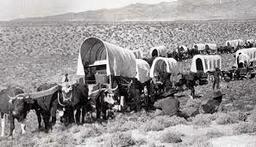
Settling the West
Quiz by Tanya Waldon
Feel free to use or edit a copy
includes Teacher and Student dashboards
Measure skillsfrom any curriculum
Measure skills
from any curriculum
Tag the questions with any skills you have. Your dashboard will track each student's mastery of each skill.
With a free account, teachers can
- edit the questions
- save a copy for later
- start a class game
- automatically assign follow-up activities based on students’ scores
- assign as homework
- share a link with colleagues
- print as a bubble sheet
7 questions
Show answers
- Q1Using the timeline on pages 4-5, which happened first: the passage of the Homestead Act or the end of the Civil War?1862: Congress passes the Homestead Act. 1865: The Civil War ends.30s
- Q2Using evidence found in the illustration on page 5, how would you describe the process of panning for gold?Miners use shovels to scoop up dirt and rocks from a stream. They dump it into a wooden channel. Water in the channel washes the dirt and rocks and moves it towards another miner. The second minor scoops dirt from the water into a pan and looks for gold.120s
- Q3What is a gold rush?A gold rush occurs after gold is found in an area. Many prospectors “rush” to the area to find gold. Often, other businesses open nearby to support the miners.120s
- Q4Where can you find evidence that supports your answer? (What is a gold Rush?)But in 1858, prospectors did find gold again….The rush was on! Within months, thousands of wagons rolled across the Great Plains…in search of gold…. page 6120s
- Q5What key details show two ways farmers on the Great Plains adapted to the shortage of wood?Since few trees grew on the prairies, settlers made houses out of sod….Since wood was in short supply, farmers built fences with a new invention called ‘barbed wire.120s
- Q6What context clues help the reader understand the meaning of the word "hardy" on page 17?able to survive in difficult conditions120s
- Q7What was the Battle of Little Bighorn?A battle between the Lakota and Cheyenne people and the U.S. Army. It occurred in June 1876. During the battle Lakota and Cheyenne forces killed Colonel Custer and all of his men.120s
